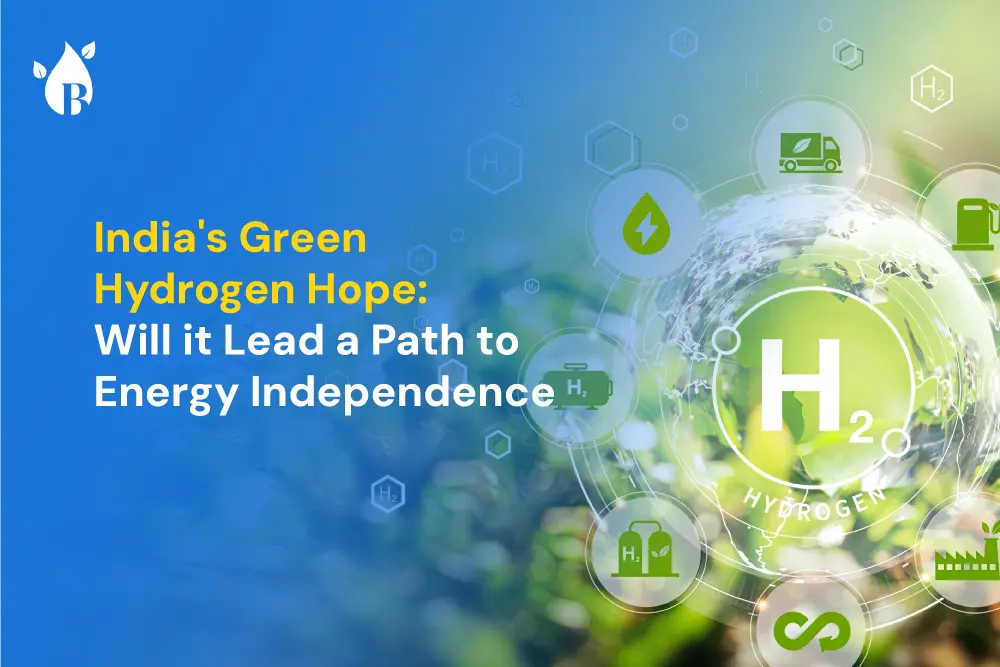
Are the world and India doing enough to keep global temperatures below 1.5 ºC? With a big push towards energy transition and substantial budget commitments in India, green hydrogen is becoming a vital solution for decarbonization. But is this focus leading to real changes? Let’s explore why the Indian government is prioritizing green hydrogen and how.
Definition of Green Hydrogen
The Ministry of New & Renewable Energy, India has decided to define Green Hydrogen as having a well-to-gate emission (i.e., including water treatment, electrolysis, gas purification, drying and compression of hydrogen) of not more than 2 kg CO2 equivalent / kg H2. To put it simply, it is a hydrogen fuel made from renewable energy, not fossil fuels. It can offer clean power for manufacturing, transportation, and other needs, with water as its only byproduct.
Nearly, 90% of all atoms are considered to be made of hydrogen. Unfortunately, it does not exist in nature by themselves. One to extract it out of the elements (like water, plants, etc) they occur to produce it. Hence, this extraction method determines the sustainability of hydrogen energy.
Interestingly, hydrogen is a versatile component and available abundantly in nature, making its supply seemingly limitless. Also, it can be produced right where it is and transported however one needs. Moreover, excess renewable energy can be used to produce hydrogen, which can then be stored for long periods. Given that hydrogen packs nearly three times the energy of fossil fuels, less of it is required for tasks. Plus, green hydrogen can be generated anywhere with water and electricity, offering a significant advantage.
Why Green Hydrogen Matters for India?
India aims for energy independence by 2047 and net-zero emissions by 2070. Green Hydrogen is key to achieving these goals. It’s made via electrolysis, splitting water using renewable electricity, like solar or wind, into hydrogen and oxygen. This process yields a clean fuel, vital for replacing fossil fuels and cutting carbon emissions. Another method involves biomass gasification, equally clean and sustainable. This makes Green Hydrogen attractive for transitioning to a low-carbon future.
Its demand is soaring due to its potential to decarbonize various sectors like transportation, shipping, and steel. It can replace fossil fuels in transportation and be used in industry for producing ammonia, methanol, and steel. Moreover, it can serve as a backup energy source for renewables, ensuring a steady energy supply.
Green Hydrogen finds use in fuel cells for vehicles and electricity, heating systems, and chemical and fertilizer production. With higher energy density and efficiency than combustion engines, it’s ideal for vehicle power. It’s also useful in microgrids, providing power to remote areas and fostering energy independence.
For India, Green Hydrogen is crucial in achieving energy independence. Its production from renewables ensures energy security, reducing reliance on fossil fuels and costly imports. Utilizing waste biomass for production also benefits local communities economically.
National Green Hydrogen Mission
In 2021, the Indian Government introduced the National Green Hydrogen Mission. Since then, significant efforts have been made to establish a strong policy framework facilitating the production and utilization of green hydrogen. The Indian government has allocated nearly $2.4 billion for the implementation of the National Green Hydrogen Mission by 2030. This budget includes key initiatives such as domestic manufacturing of electrolyzers, pilot projects in various applications, and research and development.
India aims to achieve a green hydrogen production capacity of 5 million metric tons (MMT) per year by 2030, with a potential increase to 10 MMT per year depending on export market growth. The mission is anticipated to attract around 8 trillion Indian rupees (INR) in investment, generate 600,000 jobs, reduce 50 MMT of CO2 emissions, and save 1 trillion INR in fuel imports.
The implementation of the mission is progressing, with the government recently formalizing two incentive schemes. The first scheme incentivizes electrolyzer manufacturing, offering a base incentive of 4,440 INR per kilowatt in the initial year, gradually decreasing over five years. The second scheme encourages green hydrogen production, providing a direct incentive capped at 50 INR per kilogram in the first year, tapering down over three years.
The implementation of the mission is progressing, with the government recently formalizing two incentive schemes. The first scheme incentivizes electrolyzer manufacturing, offering a base incentive of 4,440 INR per kilowatt in the initial year, gradually decreasing over five years. The second scheme encourages green hydrogen production, providing a direct incentive capped at 50 INR per kilogram in the first year, tapering down over three years.
India’s Green Hydrogen Standard mandates that hydrogen produced from renewable energy sources must emit greenhouse gases no greater than 2 kg CO2 equivalent per kg of hydrogen. Additional incentives for green hydrogen developers include waivers for interstate transmission charges, priority grid access, and concessional prices for renewable energy procurement.
While the initial focus is on industrial sectors like refineries and fertilizer production, where hydrogen is already utilized, the mission may expand to include heavy transport, steel, and power sectors. Pilot projects are planned for these industries during the implementation phase.
While the initial focus is on industrial sectors like refineries and fertilizer production, where hydrogen is already utilized, the mission may expand to include heavy transport, steel, and power sectors. Pilot projects are planned for these industries during the implementation phase.
As part of the research and innovation component, the government has unveiled a 1 billion INR R&D roadmap to enhance the efficiency and cost-effectiveness of green hydrogen production, storage, and transportation. Several Indian states have also announced green hydrogen policies to encourage investment in green hydrogen or green ammonia projects for domestic use or export.
Final Thoughts
To conclude, green hydrogen holds huge promise for cutting carbon emissions, decarbonizing industries, and attaining energy self-reliance. Made from renewables like solar, wind, and hydropower, it’s eco-friendly and sustainable, ideal for moving towards a greener future. It can replace fossil fuels in transportation and industry, ensuring a steady energy supply and reducing reliance on non-renewable sources.



